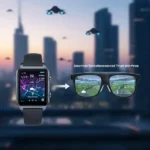Smart Glasses Accessibility Tech: Emerging Technologies and Their Potential for Accessibility
Smart glasses are rapidly evolving beyond simple notification devices. Emerging technologies are poised to revolutionize how we interact with information and the world around us, offering exciting possibilities for individuals with disabilities. This article explores four key advancements in smart glasses: light field displays, spatial computing, improved haptics, and brain-computer interfaces (BCIs), discussing their potential benefits for accessibility, compatibility with iPhone and Android, best use cases, troubleshooting, and frequently asked questions.
Emerging Smart Glasses Accessibility
1. Light Field Displays
Traditional displays project a flat image at a fixed focal distance, which can cause eye strain and limit the perception of depth. Light field displays project a complex array of light rays, creating realistic three-dimensional holographic images that the eye can focus on naturally at different distances.
Benefits for Accessibility:
- Enhanced visual clarity: For individuals with low vision, light field displays could offer a more natural and comfortable viewing experience with improved depth perception.
- Interactive 3D overlays: Imagine receiving step-by-step navigation with 3D arrows floating in your field of view, or detailed product information appearing as you look at an object.
- Improved augmented reality (AR) experiences: More realistic and immersive AR could enhance educational tools, remote assistance, and environmental awareness for users with various disabilities.
2. Spatial Computing
Spatial computing allows smart glasses to understand and interact with the physical environment around the user. Using sensors like cameras, depth sensors, and accelerometers, these devices can map the user’s surroundings and anchor digital information to specific locations.
Benefits for Accessibility:
- Hands-free interaction: Individuals with motor impairments could benefit from controlling devices and applications through gestures or gaze tracking within their spatial environment.
- Context-aware information: Smart glasses could provide real-time information relevant to the user’s location and surroundings, such as identifying objects, reading text aloud, or providing navigation cues.
- Virtual assistants integrated with the real world: Imagine a virtual assistant that can visually guide you to a specific item in a cluttered room or provide information about a piece of artwork as you stand before it.
3. Improved Haptics
Haptics refers to the technology that provides tactile feedback. While early smart glasses offered limited or no haptic feedback, advancements are leading to more sophisticated and nuanced sensations, such as vibrations, textures, and even the feeling of pressure.
Benefits for Accessibility:
- Confirmation of virtual interactions: Haptic feedback can provide clear confirmation when a virtual button is pressed or a gesture is recognized, which is particularly useful for individuals with visual impairments.
- Enhanced navigation and guidance: Imagine feeling a subtle vibration on your wrist indicating a turn while using navigation, or a gentle tap guiding your hand to a specific object.
- More immersive AR experiences: Feeling the texture of a virtual object or the impact of a virtual collision can significantly enhance the sense of presence and realism in AR applications.
4. Brain-Computer Interfaces (BCIs)
Brain-computer interfaces (BCIs) allow direct communication between the brain and external devices. While still in early stages of development for mainstream smart glasses, BCIs hold immense potential for individuals with severe motor impairments.
Benefits for Accessibility:
- Direct control through thought: Individuals with paralysis or other severe motor limitations could potentially control smart glass functions, select options, or even communicate through thought.
- Alternative communication methods: BCIs could offer new ways for individuals who cannot speak or use traditional input methods to interact with technology and express themselves.
- Personalized and adaptive interfaces: Brain signals could potentially be used to tailor the smart glass interface and functionality to the individual user’s cognitive state and needs.
iPhone and Android Compatibility
Most current and emerging smart glasses aim for broad compatibility with both iOS (iPhone) and Android devices. They typically connect via Bluetooth and often rely on companion mobile apps for setup, control, and data synchronization. While specific features and functionalities might vary slightly between platforms, the general trend is towards universal compatibility to maximize accessibility for all users. Always check the manufacturer’s specifications to confirm compatibility with your specific device.
Best Use Cases for Smart Glasses Accessibility
These emerging technologies in smart glasses open up a wide range of impactful use cases for individuals with disabilities:
- Navigation and Wayfinding: Real-time, hands-free navigation with visual or haptic cues for individuals with visual impairments or cognitive disabilities. (Link to American Foundation for the Blind)
- Communication Assistance: Text-to-speech and speech-to-text capabilities, real-time translation, and alternative communication methods via BCIs for individuals with speech or hearing impairments. (Link to National Association of the Deaf)
- Environmental Awareness: Object recognition, scene description, and hazard detection for individuals with visual impairments. (Link to The Seeing Eye)
- Remote Assistance: Connecting with caregivers, therapists, or technical support through live video and AR overlays for remote guidance and assistance. (Link to Easterseals)
- Learning and Education: Interactive learning experiences with 3D models and spatial computing, personalized feedback, and access to information in a more engaging format for individuals with learning disabilities. (Link to Learning Disabilities Association of America)
- Daily Living Tasks: Reminders, task management, and control of smart home devices through voice commands, gestures, or even thought for individuals with cognitive or motor impairments.
- Social Interaction: Subtitles for conversations, emotion recognition cues, and facilitated communication tools for individuals with hearing impairments or social communication challenges.
Troubleshooting Common Problems
While smart glass technology is advancing rapidly, users may still encounter some common issues:
- Connectivity Issues: Ensure Bluetooth is enabled on both your smart glasses and your phone. Try unpairing and re-pairing the devices. Check for software updates for both devices.
- Battery Life: Emerging technologies can be power-intensive. Optimize usage by turning off unnecessary features and reducing screen brightness. Consider carrying a portable charger.
- Comfort and Fit: Ensure the smart glasses are properly adjusted for comfort. If they feel too tight or cause discomfort, consult the user manual or contact the manufacturer for adjustment options or alternative sizes.
- Software Glitches: Restart both your smart glasses and your connected phone. Check for app updates. If problems persist, consult the manufacturer’s support website or contact their customer service.
- Display Issues: Ensure the lenses are clean. Adjust the display settings for brightness and focus if available. If the issue persists, it could be a hardware problem requiring repair or replacement.
Frequently Asked Questions (FAQ)
Q: Are smart glasses with these advanced technologies expensive? A: Currently, many of these emerging technologies are still in development or are being implemented in high-end or specialized devices, which can be expensive. However, as the technology matures and becomes more mainstream, prices are expected to become more accessible.
Q: How do I know if my phone is compatible with a specific pair of smart glasses? A: Always check the manufacturer’s specifications or the product description, which will typically list compatible operating systems (iOS or Android) and minimum software versions.
Q: Are there any privacy concerns with smart glasses that record their surroundings? A: Privacy is a significant consideration. Most reputable manufacturers include privacy features and guidelines in their devices and software. Be aware of the device’s capabilities and review the privacy policies of any associated apps. (Link to Electronic Frontier Foundation on wearable technology privacy)
Q: How can I learn more about the latest advancements in smart glasses for accessibility? A: Follow technology news outlets, accessibility advocacy organizations, and research publications. Attend relevant conferences and webinars to stay informed about the latest developments.
Q: Will these technologies be available in mainstream smart glasses soon? A: The timeline for mainstream adoption varies for each technology. Light field displays and spatial computing are seeing increased integration in newer devices. Improved haptics are also becoming more common. BCIs for consumer smart glasses are likely further in the future but hold significant promise.
Conclusion
Emerging technologies are poised to transform smart glasses into powerful tools that can significantly enhance the lives of individuals with disabilities. Light field displays, spatial computing, improved haptics, and brain-computer interfaces offer exciting possibilities for improved communication, navigation, environmental awareness, and overall independence. As these technologies continue to develop and become more accessible, they hold the potential to break down barriers and create a more inclusive world.
Additional Helpful Content
Read more about smart glasses technology – Smart Glasses Technology – Key Technologies in Smart Glasses
More about smart glasses usability and accessibility – Smart Glasses Usability and Accessibility Issues




